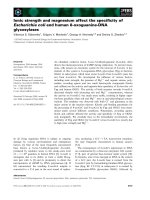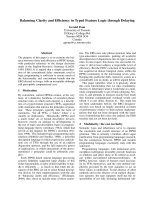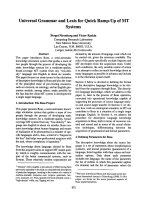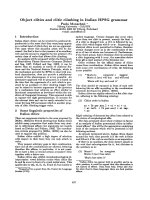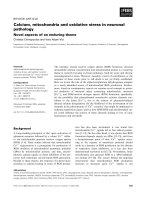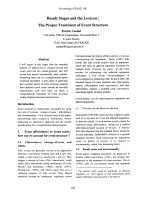báo cáo khoa học: "Enzymatic heterozygosity and morphological variance in synthetic populations of Drosophila melanogaster Gloria BLANCO LIZANA" potx
Bạn đang xem bản rút gọn của tài liệu. Xem và tải ngay bản đầy đủ của tài liệu tại đây (476.05 KB, 9 trang )
Enzymatic
heterozygosity
and
morphological
variance
in
synthetic
populations
of
Drosophila
melanogaster
Gloria
BLANCO
LIZANA
J.A.
SANCHEZ
PRADO
Departamento
de
Gen6tica,
Universidad
de
Oviedo,
Asturias,
Spain
Summary
Several
reports
have
shown
a
negative
correlation
between
allozyme
heterozygosity
and
morphological
variance
and
asymmetry.
In
this
work,
carried
out
on
synthetic
populations
of
Drosophila
melanogaster,
we
have
tried
to
find
out
if
a
relationship
can
be
established
between
the
variability
(and
symmetry
level)
of
4
morphometric
characters
and
homozygosity
for
5
enzymatic
loci.
Our
results
point
to
a
positive
correlation
between
morphological
variability
(and
asymmetry)
and
homozygosis
for
the
enzymatic
loci.
In
addition,
heterozygosity
of
other
loci
also
influenced
developmental
stability.
Key
words :
Morphological
variance,
enzymatic
polymorphism,
homeostasis,
Drosophila
mela-
nogaster.
Résumé
Hétérozygotie
enzymatique
et
variance
morphologique
dans
des
populations
synthétiques
de
Drosophila
melanogaster.
Plusieurs
expériences
montrent
qu’un
taux
élevé
d’hétérozygotie
(de
l’individu
ou
de
la
population)
est
généralement
associé
à
une
faible
variance
morphologique
et
un
faible
degré
d’asymétrie.
Dans
ce
travail,
réalisé
dans
des
populations
synthétiques
de
Drosophila
melanogaster,
nous
avons
essayé
de
voir
s’il
était
possible
d’établir
une
relation
entre
la
variabilité
(et
l’asymétrie)
de
4
caractères
morphométriques
et
le
taux
d’homozygotie
déterminé
sur
5
locus
enzymatiques.
Nos
résultats
indiquent
une
corrélation
positive
entre
variabilité
(et
asymétrie)
morphologique
et
taux
d’homozygotie
déterminé
sur
les
locus
enzymatiques
analysés.
De
plus,
le
taux
d’homozygotie
du
reste
du
génome
influe
aussi
sur
la
stabilité
du
développement.
Mots
clés :
Variance
morphologique,
polymorphisme
enzymatique,
homéostasie,
Drosophila
melanogaster.
I.
Introduction
Recently
a
lot
of
data
have
been
put
forward
showing
that
morphological
variabi-
lity
and
asymmetry
decrease
with
heterozygosity
of
enzyme
polymorphisms
(M
I
TTON
&
GRANT,
1984).
For
example,
MI
TTON
(1978)
examined
3
populations
of
Fundulus
heteroclitus
for
7
morphological
characters
and
5
polymorphic
enzyme
loci,
and
found
that
heterozygotes
tended
to
have
lower
phenotypic
variation
than
homozygotes.
E
ANES
(1978)
came
to
a
similar
conclusion
after
examining
6
polymorphic
loci
and
2
morpholo-
gical
traits
in
the
monarch
butterfly,
Danaus
plexippus.
Enzyme
heterozygosity
has
been
reported
as
associated
with
either
growth
rate
or
developmental
stability
in
a
wide
range
of
organisms :
birds
(F
LEISCHER
et
al. ,
1983),
shellfish
(S
INGH
&
Z
OUROS
,
1978 ;
Z
OUR
os
et
al.,
1980 ;
K
OEHN
&
S
HUNWAY
,
1982),
salamanders
(PIERCE
&
MI
TTON
,
1982),
fish
(V
RIJENHOECK
&
L
ERMAN
,
1982),
plants
(K
NOWLES
&
MI
TTON
,
1980 ;
MI
TTON
et
C
ll.,
1981 ;
EL
-K
ASSABY
,
1982)
and
insects
(G
UNAWAN
,
1981 ;
B
IEMONT
,
1983).
However,
there
are
a
few
results
where
these
correlations
were
not
found
(H
ANDFORD
,
1980 ;
McANDREW
et
al.,
1982).
Studies
on
symmetry
were
carried
out
on
morphological
characters
with
bilateral
distribution
(S
OULE
,
1979 ;
K
AT
,
1982 ;
L
EARY
et
al.,
1983 ;
B
IEMONT
,
1983),
because
bilateral
symmetry
is
a
direct
measure
of
developmental
homeostasis,
which
is
the
main
cause
to
which
several
authors,
according
to
the
classical
work
of
L
ERNER
(1954),
attribute
this
relationship.
In
fact,
if
developmental
homeostasis
is
defined
as
the
capability
of
an
organism
to
form
an
average
phenotype
in
the
face
of
external
perturbations
(L
ERNER
,
1954),
a
small
deviation
from
bilateral
symmetry
should
consti-
tute
a
reasonable
measure
of
a
decrease
in
homeostasis
(S
OULE
,
1967
and
1979).
Generally,
the
authors
found
it
difficult
to
account
for
their
finding
that
enzyme
heterozygotes
are
less
variable
than
homozygotes.
In
particular
they
found
it
surprising
that
such
effects
should
be observed
when
only
5
or
6
loci
were
screened
out
of
the
thousands
expected
to
be
polymorphic.
In
recent
papers
different
possible
mechanisms
are
suggested.
K
OBLIANSKY
&
L
IVSHITS
(1983),
in
human
populations,
and
L
EDING
et
al.
(1983),
in
pitch pine,
are
inclined
to
attribute
the
correlation
to
inbreeding.
L
EARY
et
al.
(1984)
considered
that
the
particular
enzyme
locus
itself
influenced
development.
MI
TTON
&
K
OEHN
(1985),
propose
that
enzyme
heterozygosity
is
linked
to
energy
budgets
of
individuals
and
that
the
developmental
stability
reflects
the
energy
balance.
The
explanation
of
why
they
exhibit
greater
developmental
stability
is
that
heterozy-
gotes
have,
on
the
average,
a
higher
positive
energy
balance,
and
these
genotypes
should
be
less
affected
during
development
by
stressing
environmental
variations.
These
results
are
also
germane
to
the
controversy
concerning
the
adaptive
signifi-
cance
of
protein
polymorphisms.
If
the
negative
correlation
between
enzyme
heterozy-
gosity
and
morphological
variability
and
asymmetry
is,
in
fact,
general,
these
correla-
tions
cannot
be
in
agreement
with
a
neutral
theory
for
the
origin
and
maintenance
of
enzyme
polymorphisms.
The
variation
at
these
enzymatic
loci
should
be
maintained,
at
least
in
part,
by
a
heterozygous
advantage
(McA
ND
REW
et
al. ,
1982 ;
L
EARY
et
al. ,
1984).
In
our
work,
carried
out
on
synthetic
populations
of
Drosophila
melanogaster,
we
have
examined
the
relationship
between
the
variability
and
symmetry
of
morphometric
characters
and
degree
of
homozygosity
for
5
biochemical
loci
chosen
at
random.
In
addition,
our
experimental
design
allowed
us
to
measure
the influence
of
heterozygosity
of
the
background
genotype.
II.
Materials
and
methods
Using
a
balanced
lethal
stock
(CyL/Pm
TM3/Pr),
isochromosomal
lines
for
chro-
mosomes
II
and
III
were
established
from
a
natural
population
of
Drosophila
melano-
gaster
recently
caught
in
the
wild.
Of
these
lines,
117
were
chosen
because
they
did
not
present
inversions,
and
were
homozygous
for
the
different
allelic
variants
of
the
5
enzymatic
loci
analyzed
(Adh,
Aph-l,
Est-6,
a-Gpdh
and
Lap-D).
Taken
as
a
whole
these
lines
constitute
what
we
shall
call
highly
homozygous
population
(HHP).
The
HHP
lines,
with
the
same
genotype
for
the
5
enzymatic
loci,
were
crossed
and
maintained
by
mass-culture.
The
8
subpopulations
so
formed,
altogether,
constitute
what
we
shall
term
partially
homozy-
gous
populations
(PHP).
In
these
PHP,
the
5
enzymatic
loci
were
in
a
homozygous
state,
but
the
background
genotype
of
the
natural
population
was
partially
reconstruc-
ted,
because
in
all
cases
10
or
more
HHP
lines
were
pooled
(N
Ei
et
al. ,
1975).
Finally,
the
PHP
lines
with
complementary
genotypes
for
the
5
enzymatic
loci
were
crossed ;
the
offspring
of
these
4
possible
crosses
were
immediately
analyzed,
and
will
be
referred
to
as
heterozygotes
(HET).
The
numbers
of
dorsocentral,
scutellar,
sternopleural
and
fifth
abdominal
sternite
bristles
have
been
studied
as
morphometric
characters.
All
but
the
last
of
these
are
bilateral
characters
and
they
exhibit
fluctuating
asymmetry
in
the
populations
because
the
difference
between
a
character
on
the
left
and
right
sides
of
individuals
is
normally
distributed
about
a
mean
of
zero.
In
these
cases
the
bristle
numbers
were
determined
for
the
left
and
right
sides
on
every
individual.
The
individuals
were
then
classified
according
to
the
absolute
values
of
the
difference
between
bristle
number
on
the
right
and
left
sides.
We
calculated
the
morphological
variance
(s’)
over
all
the
individuals
sampled
in
each
class
(HHP,
PHP
and
HET) ;
the
asymmetry
percentage
(A)
is
the
average
deviation
shown
by
the
individuals
in
each
class
and
the
symmetry
variation
range
(D)
represents
the
minimum
and
maximum
values of
asymmetry
found
in
each
class.
Moreover,
we
know
that
the
homozygotes
for
the
different
electromorphs
do
not
differ
from
each
other with
respect
to
the
average
values
of
any
of
these
morphometric
characters
(B
LANCO
&
Runic,
1983).
Horizontal
starch
gel
electrophoresis
was
carried
out
with
12
p.
100
starch.
Flies
were
homogenized
in
0.01
ml
of
gel
starch
buffer,
using
the
method
of
J
OHNSON
(1964).
References
of
buffer
and
stain
systems
utilized
are
indicated
in
table
1.
III.
Results
and
discussion
The
null
hypothesis
tested
here
is
that
heterozygous
individuals
for
the
5
enzymatic
loci
have
the
same
level
of
symmetry
and
morphological
variance
as
the
individuals
homozygous
for
the
same
loci.
Table
2
shows
the
variance
of
morphometric
characters
in
the
3
classes
of
populations
analyzed,
and
table
3
shows
the
results
on
bilateral
symmetry.
The
values
of
asymmetry
(A),
were
compared
with
a
t-test
corrected
for
unequal
variances,
and
the
morphological
variances
by
a
one-tailed
F-test
(S
OKAL
&
R
OHLF
,
1979).
The
sample
size
(n)
is
the
number
of
individuals
analyzed
in
each
population,
taken
from
all
the
lines
of
each
class.
In
all
cases
the
HHP
individuals
showed
both
the
greatest
variance
for
the
4
morphometric
characters
analyzed
(tabl.
2)
and
a
greater
deviation
with
respect
to
the
bilateral
symmetry
(tabl.
3).
On
the
other
hand,
the
HET
individuals
displayed
the
least
variance
and
the
greatest
degree
of
symmetry ;
11
of
the
14
comparisons
made
between
both
classes
of
individuals
were
statistically
significant
(tabl.
2
and
3).
The
PHP
individuals
showed
intermediate
variance
and
symmetry
values
(tabl.
2
and
3) ;
they
differ
significantly
from
the
HET
in
2
of
the
6
comparison
made
and
from
the
HHP
in
4
of
the
6
comparisons
(tabl.
2
and
3).
The
same
results
were
obtained
using
the
magnitude
of
asymmetry.
In
2
of
the
3
characters
the
HET
showed
the
least
symmetry
variation
range
(tabl.
3
and
fig.
1).
These
results
are
similar
to
those
obtained
in
other
works
where
it
becomes
evident
that
the
homozygous
individuals
show
greater
variability
for
morphometric
traits
(estimated
by
variance,
coefficient
of
variation,
degree
of
symmetry,
etc.)
than
the
ieterozygous
(see
MI
TTON
&
GRANT,
1984,
for
a
review).
In
our
case,
when
we
compared
the
HET
with
the
homozygous
individuals
(HHP
and
PHP),
the
same
tendency
was
observed :
the
homozygous
showed
greater
variance
and
greater
asymmetry
for
the
morphometric
characters
analyzed.
However,
the
diffe-
rences
between
HHP
and
HET
were
statistically
significant
in
79
p.
100
of
the
cases,
whereas
the
differences
between
PHP
and
HET
were
only
statistically
significant
in
33
p.
100
of
the
comparisons
made.
The
HHP
differ
significantly
from
the
PHP
individuals
in
66
p.
100 of
the
cases.
These
differences
were
not
due
to
differences
in
the
5
biochemical
loci
analyzed
(both
types
of
individuals
were
homozygous
for
them),
but
to
the
homozygosity
level
of
the
rest
of
the
genotype
(the
HHP
individuals
are
totally
homozygous
for
chromosomes
II
and
III,
which
represent
approximately
80
p.
100
of
all
the
genome
of
D.
melanogaster,
L
EW
O
NTIN
,
1974).
The
comparisons
made
between
HET
and
PHP
individuals
were
similar
in
type
to
those
carried
out
in
other
works
dealing
with
individuals
taken
from
natural
popula-
tions.
In
both
cases
the
individuals
were
classified
according
to
their
level
of
homozygo-
sity
for
some
biochemical
loci.
In
our
case
the
differences
between
HET
and
PHP
were
due,
fundamentally,
to
the
genetic
constitution
which
these
individuals
showed
for
the
5
biochemical
loci
analyzed.
For
the
rest
of
genotype
there
was
no
evidence
to
suggest
that
there
were
differences
between
them,
because
to
obtain
the
PHP
and
the
HET
populations,
a
minimum
of
10
or
20
different
lines
were
pooled
(see
Material
and
methods).
NEi
et
al.
(1975)
have demonstrated
that
a
random
sample
of
10
chromo-
somes
from
a
natural
population
permits
reconstruction of
about
90
p.
100
of
the
total
genetic
variability
contained
in
these
natural
populations.
The
data
presented
reject
the
null
hypothesis
tested
here
and
are
consistent
with
the
hypothesis
that
the
higher
the
homozygosity
level
the
further
away
these
individuals
are
from
the
center
of
the
morphological
character
distribution
and
from
bilateral
symmetry.
These
relationship
between
protein
heterozygosity
and
developmental
stability
appear
to
be
general,
but
they
are
certainly
not
universal
(H
ANDFORD
,
1980 ;
McAN-
DREW
et
al. ,
1982).
Certainly,
these
relationships
are
not
expected
in
all
characters,
S
OULE
(1982)
predicts
that
this
relationship
is
more
likely
to
be
found
when
stabilising
selection
can
be
shown
to
operate
on
the
character
analysed.
The
negative
results
reported
by
McANDREW
et
al.
(1982)
in
the
plaice
(Pleuronectes
platessa)
may
fit
this
prediction.
In
the
present
study
2
of
the
morphological
characters
(dorsocentral
and
scutellar
bristles)
showed
a
strong
canalization
in
natural
populations
of
D.
melanogas-
ter,
whereas
in
the
other
two
(sternopleural
and
fifth
abdominal
sternite
bristles)
no
stabilising
selection
can
be
demonstrated.
However,
in
our
case
the
2
types
of
characters
showed
the
same
tendency
with
respect
to
the
enzymatic
heterozygosity
(tabl.
2
and
3) ;
the
HET
were
less
variable
and
more
symmetric
than
homozygous
individuals.
This
negative
correlation
between
allozyme
heterozygosity
and
morphological
variance
and
asymmetry
may
be
interpreted
in
different
ways.
One
interpretation
suggests
that
the
biochemical
marker
loci
are
linked
to
genes
determining
the
morpho-
logical
character ;
the
observed
relationship
is
caused
by
linked
genes
or
chromosome
segments
and
not
by
the
enzyme
loci
alone.
This
hypothesis
does
not
seem
feasible
to
explain
our
results
because :
a)
It
is
difficult
to
accept
that
from
among
thousands
of
biochemical
loci
of
Drosophila,
5
of
them,
chosen
at
random,
are
associated
with
morphological
trait
loci,
also
chosen
at
random.
b)
Our
synthetic
populations
have
no
chromosomal
inversion.
c)
Linkage
disequilibrium
is
not
a
common
phenomenon
in
populations
of
Droso-
phila ;
surveys
of
natural
populations
generally
reveal
little
or
no
linkage
disequili-
brium,
and
studies
in
experimental
populations
reveal
that
the
linkage
disequilibrium
initially
generated
by
stochastic
processes
decays
quickly
(H
EDRICK
et
al. ,
1978 ;
C
LEGG
et
al.,
1980 ;
SnrrcHEZ
&
R
UBIO
).
Another
possibility,
considered
by
LE
nxY et
al.
(1984),
is
that
the
heterozygosity
of
the
enzymes
causally
influences
development.
In
this
case,
the
effect
is
due
to
the
enzyme
itself.
Their
results
with
the
locus
Ldh-3
of
rainbow
trout
indicate
that
null
allele
heterozygotes
are
more
asymmetrical
than
homozygotes
for
the
active
allele
and
they
suggest
that
the
enzyme
locus
itself
is
affecting
asymmetry.
This
is
not
our
case,
because
preliminary
results
(B
LANCO
&
Rusio,
1983)
show
that
the
homozygotes
for
the
different
electromorphs
at
individual
loci
do
not
differ
from
each
other
with
respect
to
any
of
the
morphometric
characters
utilized
in
this
study.
Another
hypothesis
put
forward
to
explain
the
correlation
between
heterozygosity
and
developmental
stability
is
proposed
by
MrrroN
&
K
OEHN
(1985).
They
suggest
that
since
during
development
an
organism
requires
energy
for
biosynthesis
and
to
face
stressful
environmental
changes,
the
heterozygotes
should
be
less
affected
during
development
by
environmental
variations
since
these
genotypes
are,
on
the
average,
in
a
higher
positive
energy
balance,
and
because
of
this
the
heterozygotes
exhibit
greater
developmental
stability.
In
the
data
presented
here,
there
are
no
consistent
indications
to
reject
or
to
accept
this
hypothesis,
but
in
our
opinion
it
seems
more
reasonable
to
explain
our
results.
In
fact,
the
heterozygosity
level
of
the
genetic
background
(HHP
vs
PHP)
as
well
as
the
heterozygosity
at
5
enzymatic
loci
(HET
vs
PHP),
show
influence
on
the
variability
level
of
morphological
characters
and
we
think
that
this
phenomenon
is
an
expression
of
a
general
heterozygous
effect.
Certainly,
more
studies
on
physiology
of
enzyme
polymorphisms
are
required.
Received
May
23,
1985.
Accepted
April
18,
1986.
References
B
IEMONT
C.,
1983.
Homeostasis,
enzymatic
heterozygosity
and
inbreeding
depression
in
natural
populations
of
Drosophila
melanogaster.
Genetica,
61,
179-189.
B
LANCO
G.,
Ru
B
to
J.,
1983.
Relaciones
entre
variantes
enzimaticas
y
caracteres
cuantitativos
en
lineas
isocromos6micas
de D.
melanogaster.
Proceeding
of
XIX
Jornadas
Luso-Espanolas
de
Genetica,
Coimbra,
20-24
septem6re
1983,
p.
157,
Instituto
Botanico
Dr.
Julio
Henriques,
Universidade
de
Coimbra,
Coimbra.
C
LEGG
M.T.,
K
IDWELL
J.F.,
H
ORCH
C.R.,
1980.
Dynamics
and
correlated
genetic
systems.
V.
Rates
of
decay
of
linkage
disequilibria
in
experimental
populations
of
Drosophila
melanogas-
ter.
Genetics,
94,
217-234.
E
ANES
W.F.,
1978.
Morphological
variance
and
enzyme
heterozygosity
in
the
monarch
butterfly.
Nature,
276,
263-264.
EL
-K
ASSnsY
Y.A.,
1982.
Associations
between
allozyme
genotypes
and
quantitative
traits
in
Douglas-fin
(Pseudotsuga
menziesii
(miirb)
Franco).
Genetics,
101,
103-115.
F
LEISCHER
R.C.,
J
OHNSTON
R.F.,
KL1
TZ
W.J.,
1983.
Allozymic
heterozygosity
and
morphological
variation
in
house
sparrows.
Nature,
304,
628-629.
G
RELL
E.H.,
1967.
Electrophoretic
variants
of
a-glycerophosphate
dehydrogenase
in
Drosophila
melanogaster
Science,
158,
1319-1320.
G
RELL
E.H.,
J
ACOBSON
K.B.,
MURPHY
J.B.,
1965.
Alcohol
dehydrogenase
in
Drosophila
melano-
gaster.
Science,
149,
80.
G
UNAWAN
B.,
1981.
The
relationship
between
quantitative
and
allozymic
variation
in
D.
buzzatii.
In :
GtBSON
J.B.,
O
AKESHO
TT
J.G.
(ed),
Genetic
Studies
of
Drosophila
Populations,
147-157.
Australian
National
University
Press,
Canberra.
H
ANDFORD
P.,
1980.
Heterozygosity
at
enzyme
loci
and
morphological
variation.
Nature,
286,
261-
262.
H
EDRICK
P.,
J
AIN
S.,
H
OLDEN
L.,
1978.
Multilocus
systems
in
evolution.
In :
H
ECHT
M.K.,
H
OLDEN
L.,
S
TEERE
W.C.,
W
ALLACE
B.
(ed.),
Evolutionnary
Biology,
vol.
11,
101-184.
Plenum
Press,
New
York.
J
OHNSON
F.M.,
1964.
Genetic
variation
of
ADH
in
D.
melanogaster.
Nature,
204,
906-907.
K
AT
P.W.,
1982.
The
relationship
between
heterozygosity
for
enzyme
loci
and
developmental
homeostasis
in
peripheral
populations
of
aquatic
bivalves
(Unionidae).
Am.
Nat.,
119,
824-
832.
K
NOWLES
P.,
MI
TTON
J.B.,
1980.
Genetic
heterozygosity
and
radial
growth
variability
in
Pinus
contorta.
Silvae
Genetica,
29,
114-118.
K
OBYLIANSKY
E.,
L
IVSHITS
G.,
1983.
Relationship
between
biochemical
heterozygosity
and
morpho-
logical
variability
in
human
populations.
Ann.
Hum.
Genet.,
47,
215-223.
K
OEHN
R.K.,
S
HUNWAY
E.,
1982.
A
genetic/physiological
explanation
for
differential
growth
rate
among
individuals
of
the
American
oyster
Crassostrea
virginica
(Gmelin).
Mar.
Biol.
Lett.,
3,
35-42.
L
EARY
R.F.,
A
LLENDORF
F.W.,
K
NUDSEN
K.L.,
1983.
Developmental
stability
and
enzyme
hetero-
zygosity
in
rainbow
trout.
Nature,
301,
71-72.
L
EARY
R.F.,
A
LLENDORF
W.F.,
K
NUDSEN
K.L.,
1984.
Superior
developmental
stability
of
heterozy-
gotes
at
enzyme
loci
in
salmonid
fishes.
Am.
Nat.,
124,
540-551.
L
EDING
F.T.,
G
URIE
s
R.P.,
B
ONEFIELD
B.A.,
1983.
The
relation
of
growth
to
heterozygosity
in
pitch
pine.
Evolution,
37,
1227-1238.
L
ERNER
LM.,
1954.
Genetic
Homeostasis.
134
pp.,
Oliver
and
Boyd,
Edinburgh.
LE
woNTIN
R.C.,
1974.
The
genetic
basis
of
evolutionary
change.
346
pp.,
Columbia
University
Press,
New
York.
McANDREW
B.J.,
WARD
R.D.,
B
EARDMORE
J.A.,
1982.
Lack
of
relationship
between
morphological
variance
and
enzyme
heterozygosity
in
the
plaice
Pleuronectes
platessa.
Heredity,
48,
117-125.
MI
TTON
J.B.,
1978.
Relationship
between
heterozygosity
for
enzyme
loci
and
variation
of
morpho-
logical
characters
in
natural
populations.
Nature,
273,
661-662.
MI
TTON
J.B.,
K
NOWLES
P.,
STURGEON
K.B.,
L
INHART
Y.B.,
D
AVIS
M.,
1981.
Associations
between
heterozygosity
and
growth
rate
variables
in
western
forest
trees.
In :
C
ONCLE
M.T.
(ed.),
Proc.
Symp.
Isozymes
North
American
Forest
Trees
and
Forest
Insects,
USDA,
General
Technical
Report
PSW-48,
27-34.
Washington
D.C. :
USGPO.
MI
TTON
J.B.,
GRANT
M.C.,
1984.
Associations
among
protein
heterozygosity,
growth
rate,
and
developmental
homeostasis.
Ann.
Rev.
Ecol.
Syst.,
15,
479-499.
MI
TTON
J.B.,
K
OEHN
R.K.,
1985.
Shell
shape
variation
in
the
blue
mussel
Mytilus
edulis
L.,
and
its
association
with
enzyme
heterozygosity.
J.
Exp.
Mar.
Biol.
Ecol.,
90,
73-80.
N
EI
M.,
M
ARUYAMA
T.,
C
HAKRABORTY
R.,
1975.
The
bottleneck
effect
and
genetic
variability
in
populations.
Evolution,
29,
1-10.
PIERCE
B.A.,
MI
TTON
J.B.,
1982.
Allozymic
heterozygosity
and
growth
in
the
tiger
salamander,
Ambystoma
tigrinum.
J.
Heredity,
73,
250-253.
S
AKAI
R.K.,
TUNG
D.A.,
S
KANDALIOS
J.S.,
1969.
Developmental
genetics
studies
of
L-aminopepti-
dase
in
Drosophila
melanogaster.
Mol.
Gen.
Genet.,
105,
24-29.
S
ANCHEZ
J.A.,
R
UBIO
J.
Evolution
du
polymorphisme
des
loci
enzymatiques
dans
des
populations
exp6rimentales
de
Drosophila
melanogaster.
III.
D6s6quilibre
de
liaison
entre
les
loci
Adh
et
a-Gpdh
(Submitted
to
Genetica).
S
INGH
S.M.,
Z
OUROS
E.,
1978.
Genetic
variation
associated
with
growth
rate
in
the
American
oyster
(Crassostrea
virginica).
Evolution,
32,
342-345.
S
OKAL
R.R.,
R
OHLF
F.J.,
1979.
Biometria.
483
pp.,
Edi.
Blume,
Madrid.
S
OULE
M.,
1967.
Phenetics
of
natural
populations.
II.
Asymmetry
and
evolution
in
a
lizard.
Am.
Nat.,
101,
140-167.
S
OULE
M.,
1979.
Heterozygosity
and
developmental
stability :
another
look.
Evolution,
33,
396-
401.
S
OULE
M.,
1982.
Allomeric
variation.
1.
The
theory
and
some
consequences.
Am.
Nat.,
120,
751-
764.
Vp
uE
N
HOECK
R.C.,
L
ERMAN
S.,
1982.
Heterozygosity
and
developmental
stability
under
sexual
and
asexual
breeding
systems.
Evolution,
36,
768-776.
W
ALLIS
B.B.,
Fox
A.S.,
1968.
Genetic
and
developmental
relationship
between
two
alkaline
phosphatases
in
Drosophila
melanogaster.
Biochem.
Genet.,
2,
141.
WRIGHT
T.R.F.,
1963.
The
genetics
of
an
esterase
in
Drosophila
melanogaster.
Genetics,
48,
787-
801.
Z
OUR
os
E.,
S
INGH
S.M.,
MILES
H.E.,
1980.
Growth
rate
in
oyster :
an
overdominant
phenotype
and
its
possible
explanations.
Evolution,
34,
856-867.

